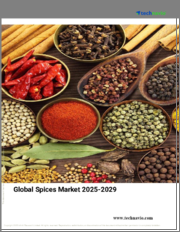
|
시장보고서
상품코드
1764824
인도의 유기농 스파이스 시장 : 제품 유형별, 형태별, 유통 채널별, 지역별, 기회, 예측(2019-2033년)India Organic Spices Market Assessment, By Product Type, By Form, By Distribution Channel, By Region, Opportunities and Forecast, FY2019-FY2033F |
||||||
인도의 유기농 스파이스 시장은 2026-2033년의 예측 기간 중 CAGR 6.48%를 기록하며, 2025년 11억 6,723만 달러에서 2033년에는 19억 2,886만 달러로 성장할 것으로 예측됩니다. 인도의 유기농 향신료 시장은 건강 지향 증가와 강황과 같은 화학물질을 사용하지 않는 천연 제품에 대한 수요가 주도하고 있습니다. 환경적 지속가능성과 윤리적 농법이 소비자들을 끌어들이고 있습니다. 정부의 지원은 유기농 재배를 장려하고, 소득 증가와 식습관의 진화는 수요를 증가시킵니다. 또한 건강 지향적인 세계 시장으로의 수출 기회 증가는 인도 유기농 향신료 산업의 성장을 더욱 촉진하고 있습니다.
인도의 유기농 향신료 시장은 화학물질이 없고 지속가능한 향신료 제품에 대한 국내외 시장의 선호도를 결정하는 몇 가지 중요한 촉진요인으로 인해 성장하고 있습니다. 주요 시장 성장 촉진요인은 유기농 제품의 건강상의 이점에 대한 소비자의 이해도가 높아지면서 구매자들이 기존 제품 대신 순수하고 영양가 높은 선택을 하게 되는 것입니다. 유기농 향신료 산업은 공식적인 인증 과정과 함께 유기농 농가에 재정적 지원을 제공하는 정부 프로그램의 강력한 지원을 받고 있습니다. 정부 정책은 농업 생산자들이 유기농법으로 전환할 수 있는 동기를 부여하고, 국제 표준을 준수하고 수출 능력을 향상시킬 수 있도록 보장합니다. 인도 전역의 기후 조건은 강황, 커민, 카다몬, 후추 등 다양한 향신료의 생육을 가능하게 하여 인도는 유기농 향신료 생산의 선두주자로 자리매김하고 있으며, E-Commerce 플랫폼의 개발과 소비자 직접 판매 방식은 유기농 향신료 브랜드들의 고객 도달 범위를 확장하고 원래 시장 공간을 넘어 서비스를 제공하는 데 있으며, 필수적인 중요성을 가지고 있습니다. 더 나은 공급망 관리와 환경 친화적인 포장 방법의 조합은 제품의 신선도와 정품 품질을 보호합니다.
목차
제1장 프로젝트 범위와 정의
제2장 조사 방법
제3장 미국 관세의 영향
제4장 개요
제5장 고객의 소리
- 응답자 인구통계
- 브랜드 인지도
- 구입 결정시 고려되는 요소
- 구입 후에 직면하는 과제
- 선호되는 유통 채널
제6장 인도의 유기농 스파이스 시장 전망, 2019-2033년
- 시장 규모 분석과 예측
- 금액별
- 시장 점유율 분석과 예측
- 제품 유형별
- 마늘
- 생강
- 터메릭
- 쿠민
- 시나몬
- 기타
- 형태별
- 홀
- 분말
- 종자
- 기타
- 유통 채널별
- 슈퍼마켓/하이퍼마켓
- 편의점
- 온라인
- 기타
- 지역별
- 북부
- 동부
- 서부와 중부
- 남부
- 기업별 시장 점유율 분석(상위 5사·기타 - 금액 기반, 2025년)
- 제품 유형별
- 2025년 시장 맵 분석
- 제품 유형별
- 형태별
- 유통 채널별
- 지역별
제7장 수입과 수출 분석
제8장 밸류체인 분석
제9장 Porter's Five Forces 분석
제10장 PESTLE 분석
제11장 가격 분석
제12장 시장 역학
- 시장 성장 촉진요인
- 시장이 해결해야 할 과제
제13장 시장 동향과 발전
제14장 정책과 규제 상황
제15장 사례 연구
제16장 경쟁 구도
- 시장 리더 상위 5사의 경쟁 매트릭스
- TOP 5사의 SWOT 분석
- 시장 TOP 10사의 주요 기업 상황
- ITC Limited(owner of 24 Mantra Organic)
- Green Earth Products Private Limited
- Pro Nature Organic Foods Private Limited
- PDS Organic Spices
- Carmel Organics
- Geo-fresh Organic Private Limited
- Phalada Organic Consumer Products Private Limited(Pure &Sure)
- Natureland Organic Foods Private Limited
- Mehrotra Consumer Products Private Limited(Organic Tattva)
- Conscious Food Private Limited
제17장 전략적 제안
제18장 조사회사 소개·면책사항
KSA 25.07.16India organic spices market is projected to witness a CAGR of 6.48% during the forecast period FY2026-FY2033, growing from USD 1,167.23 million in FY2025 to USD 1,928.86 million in FY2033. The Indian organic spices market is driven by rising health consciousness and demand for chemical-free, natural products like turmeric. Environmental sustainability and ethical farming practices attract consumers. Government support encourages organic cultivation, while increasing incomes and evolving food preferences boost demand. Additionally, growing export opportunities to health-focused global markets further propel the growth of India's organic spices industry.
India organic spices market receives its growth from several essential drivers that determine domestic and international market preferences for chemical-free, sustainable spice products. The primary market driver is the expanding consumer understanding of organic product health advantages, which leads buyers to choose pure and nutritious options instead of conventional products. The organic spice industry receives strong support from government programs, which provide financial assistance to organic farmers along with official certification processes. The government policies motivate agricultural producers to switch to organic farming methods, which guarantee international standard compliance and better export capabilities. The climatic conditions throughout India enable the successful growth of various spices, including turmeric and cumin, along with cardamom and black pepper, which establishes the nation as an organic spice production leader. The development of e-commerce platforms together with direct-to-consumer sales methods has essential importance in expanding customer reach for organic spice brands to serve beyond their original market spaces. The combination of better supply chain management and environmentally friendly packaging methods protects product freshness and genuine quality.
Rising Health Consciousness Drives the India Organic Spices Market Demand
India organic spice market is increasing in demand because of increasing value, health benefits, and authentic natural products alongside nutritional value. Indian consumers who understand pesticide and chemical additive dangers are moving toward wellness-promoting organic turmeric and cumin, along with black pepper and other organic spices.
The increase in lifestyle diseases such as diabetes and cardiovascular problems has created stronger market demand for chemical-free products, which pushes brands to launch more organic spice choices. The government's backing of organic farming through certification programs creates quality standards that make consumers trust organic products more.
For Instance, in March 2023, Vahdam Teas Pvt Ltd delivers high-quality organic spices from Indian farms, which are available to customers. They launched Kitchen Essentials Box contains nine tested organic spices. This market expansion helps develop India's organic spice sector and supports sustainable procurement methods.
Government Initiatives and Export Growth Fuel the Market Growth
The organic spices market in India advances through export growth and governmental support, which creates sustainability along with quality and international market competitiveness. The Spices Board initiated the SPICED scheme, which provides financial aid to support value-added spice export sustainability through replanting and micro-irrigation, and post-harvest infrastructure development.
The scheme enhances productivity while encouraging organic and GI-tagged spice production, and this helps increase India's position in international trade.
Regulatory structures also play an important role in ensuring high standards. The FSSAI guidelines determine stringent rules for spice quality, which guarantee compliance with food safety norms. The applied measures enhance consumer confidence and guard against counterfeiting of organic spice products. Certifications show the industry's commitment to organic cultivation through USDA, EU, and NPOP standard adherence, ensuring ethical sourcing of superior products. The increased global demand for chemical-free, ethically produced spices has spurred export expansion so that India is now a dominant player in global spice markets. Growth results due to government-backed trade agreements and improved logistics infrastructure, and sustainable farming operations.
Further, the wider distribution capabilities of e-commerce platforms position India's organic spice industry for enduring success because it matches the worldwide move toward sustainability and health-focused consumption.
Powdered Form Segment Dominates the India Organic Spices Market Share
The segment of powdered form holds the highest market share within India organic spices market because of its practical benefits and growing consumer trend toward convenient ingredients. The household sector, together with food processing industries and Ayurveda, extensively utilizes organic spice powders, which include turmeric alongside cumin, coriander, and chili for their essential role in both domestic and international markets. The market domination of these products stems mainly from their ability to remain fresh longer than whole spices, which results in superior potency along with better aroma retention and simpler storage. The rising preference of urban consumers and food service providers for quick cooking options has increased the market demand for powdered spices. The export market achieves advantages from powdered organic spices because these products maintain consistent quality during transportation, which allows large shipments to be sent worldwide. The organic spice industry in India maintains its leading position in the market because e-commerce platforms provide better customer access, and people choose health-focused, sustainable products. The market dominance of organic spice powders increases because of better packaging methods combined with thorough quality supervision, which makes them the top choice for contemporary consumers.
South Region Dominates the India Organic Spices Market
The Southern part of India controls most of the organic spices industry because of its suitable environment and natural diversity, and long-standing expertise in spice production. Kerala, together with Karnataka and Tamil Nadu, and Andhra Pradesh, produces top-quality organic spices, which include black pepper, cardamom, turmeric, and cinnamon. The tropical conditions, together with nutrient-rich soil, create perfect circumstances for organic farming, which produces substantial harvests and exceptional taste qualities.
South India maintains its market leadership because of ancient trade routes and spice cooperatives that help farmers obtain organic certifications and maintain sustainable farming methods. The large number of organic spice estates and farmer collectives enables the production of top-quality spices while maintaining efficient supply networks. The Spices Board of India and government incentives, together with certification programs, support farmers who want to increase their organic spice cultivation in the region.
The rising worldwide interest in organic spices has established South India as the leading export center, which maintains its market leadership position. The region's competitive edge benefits from its modern processing facilities combined with sustainable packaging solutions and strong e-commerce platforms, which drive its continuous market expansion. The South leads India's organic spice industry through its evolving standards that emphasize both quality and sustainability.
Impact of U.S. Tariffs on India Organic Spices Market
The implementation of U.S. tariffs on Indian organic spices creates higher expenses for exporters, which decreases product competitiveness on in American market. The elevated tariffs make vendors choose between absorbing revenue reductions or increasing their costs, which decreases product demand and reduces India's status as the leading organic spice exporter worldwide.
The increasing tariffs push Indian exporters toward seeking new markets, including the European Union and Middle Eastern countries. When trade routes expand, businesses need to adjust to regulatory requirements and consumer preferences across markets, which creates a complex process that extends market access time.
The implementation of tariffs creates revenue interruptions for Indian organic spice producers who depend on U.S. exports, especially for small-scale farmers. The decreased demand creates economic difficulties for the whole supply chain, which affects cultivation through processing and packaging stages and may result in changes to domestic market priorities.
The export limitations created by tariffs drive India's organic spice industry to develop a stronger domestic market for consumption. Through e-commerce channels and organic certification programs, companies can focus on reaching local consumers to boost national sales while decreasing their dependence on international markets for revenue stability.
Key Players Landscape and Outlook
The primary market forces of the India organic spices industry include essential players who advance innovation alongside sustainability and global growth. The sector has players such as ITC Limited, Natureland Organics Foods Private Limited, which supply chemical-free, high-quality spices to health-focused buyers. The companies maintain complete supply chain transparency from farm to table through ethical sourcing methods and organic certification validation, together with sustainable cultivation processes.
For instance, in April 2025, ITC Limited acquired 24 Mantra Organic, a pioneer in organic packaged foods. This strategic move strengthens ITC's foothold in the organic segment by leveraging 24 Mantra's extensive farmer network and vertically integrated supply chain, enhancing both product quality and distribution efficiency. ITC's expansion into organic spices aligns with growing consumer demand for sustainably sourced products, increasing accessibility, and affordability.
India's organic spices market will experience swift expansion because of growing consumer knowledge, together with government support and rising export needs. Market expansion will receive additional support from the increasing focus on clean-label products and sustainable sourcing, and stringent quality control measures. Online platforms have enhanced organic spice accessibility through direct consumer interactions with premium, ethically sourced ingredients.
India has positioned itself as a worldwide leading exporter of organic spices while key industry players invest in technology development and sustainable packaging and farm enhancement. The strategic investments by these companies create sustainable growth opportunities that lead to ongoing innovation and market leadership for the organic spice sector.
Table of Contents
1. Project Scope and Definitions
2. Research Methodology
3. Impact of U.S. Tariffs
4. Executive Summary
5. Voice of Customers
- 5.1. Respondent Demographics
- 5.2. Brand Awareness
- 5.3. Factors Considered in Purchase Decisions
- 5.4. Challenges Faced Post Purchase
- 5.5. Preferred Distribution Channel
6. India Organic Spices Market Outlook, FY2019-FY2033F
- 6.1. Market Size Analysis & Forecast
- 6.1.1. By Value
- 6.2. Market Share Analysis & Forecast
- 6.2.1. By Product Type
- 6.2.1.1. Garlic
- 6.2.1.2. Ginger
- 6.2.1.3. Turmeric
- 6.2.1.4. Cumin
- 6.2.1.5. Cinnamon
- 6.2.1.6. Others
- 6.2.2. By Form
- 6.2.2.1. Whole
- 6.2.2.2. Powdered
- 6.2.2.3. Seeds
- 6.2.2.4. Others
- 6.2.3. By Distribution Channel
- 6.2.3.1. Supermarkets/Hypermarkets
- 6.2.3.2. Convenience Stores
- 6.2.3.3. Online
- 6.2.3.4. Others
- 6.2.4. By Region
- 6.2.4.1. North
- 6.2.4.2. East
- 6.2.4.3. West and Central
- 6.2.4.4. South
- 6.2.5. By Company Market Share Analysis (Top 5 Companies and Others - By Value, FY2025)
- 6.2.1. By Product Type
- 6.3. Market Map Analysis, FY2025
- 6.3.1. By Product Type
- 6.3.2. By Form
- 6.3.3. By Distribution Channel
- 6.3.4. By Region
7. Import and Export Analysis
8. Value Chain Analysis
9. Porter's Five Forces Analysis
10. PESTLE Analysis
11. Pricing Analysis
12. Market Dynamics
- 12.1. Market Drivers
- 12.2. Market Challenges
13. Market Trends and Developments
14. Policy and Regulatory Landscape
15. Case Studies
16. Competitive Landscape
- 16.1. Competition Matrix of Top 5 Market Leaders
- 16.2. SWOT Analysis for Top 5 Players
- 16.3. Key Players Landscape for Top 10 Market Players
- 16.3.1. ITC Limited (owner of 24 Mantra Organic)
- 16.3.1.1. Company Details
- 16.3.1.2. Key Management Personnel
- 16.3.1.3. Key Products Offered
- 16.3.1.4. Key Financials (As Reported)
- 16.3.1.5. Key Market Focus and Geographical Presence
- 16.3.1.6. Recent Developments/Collaborations/Partnerships/Mergers and Acquisitions
- 16.3.2. Green Earth Products Private Limited
- 16.3.3. Pro Nature Organic Foods Private Limited
- 16.3.4. PDS Organic Spices
- 16.3.5. Carmel Organics
- 16.3.6. Geo-fresh Organic Private Limited
- 16.3.7. Phalada Organic Consumer Products Private Limited (Pure & Sure)
- 16.3.8. Natureland Organic Foods Private Limited
- 16.3.9. Mehrotra Consumer Products Private Limited (Organic Tattva)
- 16.3.10. Conscious Food Private Limited
- 16.3.1. ITC Limited (owner of 24 Mantra Organic)
Companies mentioned above DO NOT hold any order as per market share and can be changed as per information available during research work.



















